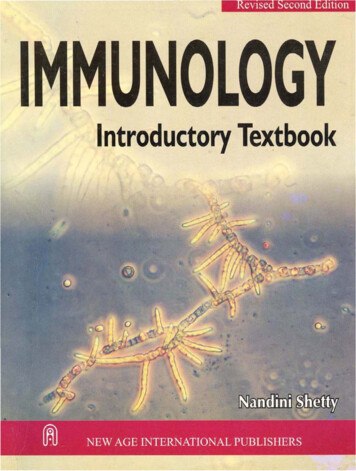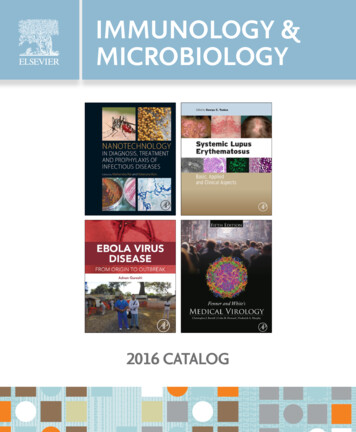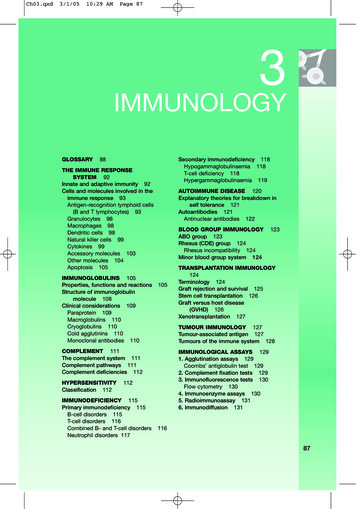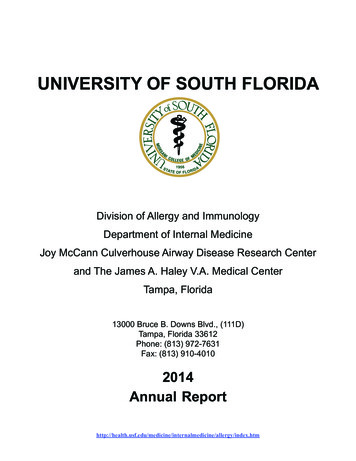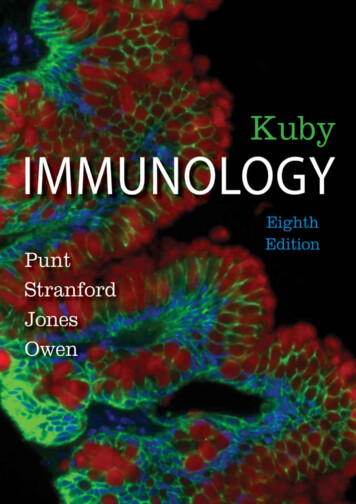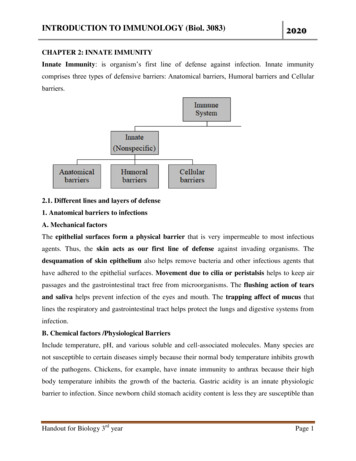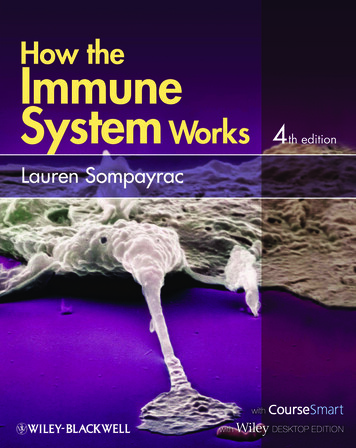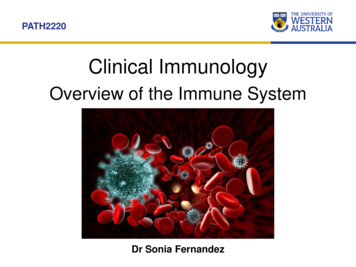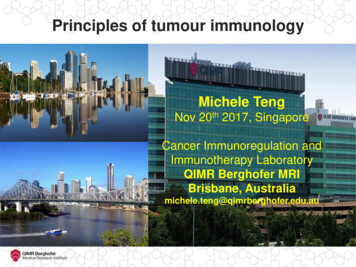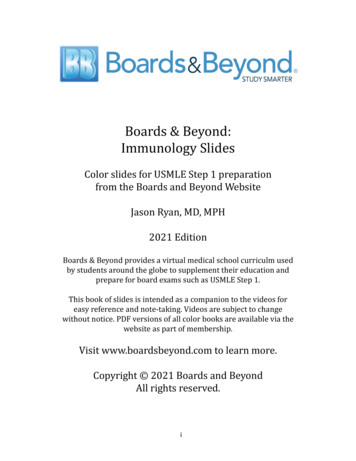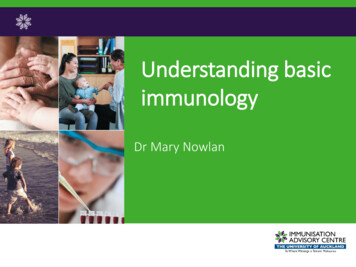
Transcription
Understanding basicimmunologyDr Mary Nowlan1
Immunology Immunology– the study of how the body fights disease andinfection Immunity– State of being able to resist a particular infectionor toxin2
Overview Function of defencesImmune response to infection and vaccinesGenerating specific immunityEnhancing the immune defences3
Functions of the immune systemProtection Identify and destroypathogens CancerHousekeeping Removal of debris anddead cells SurveillanceCommunication Chemical messages Antigen presentation Memory4
Hierarchy of defencesBarriers and chemicalsNon specificSpecific Effective but crude –Prevention First line of defence Actively identifies andremoves unwanted invaders Highly targeted Powerful but slow to develop Memory5
Self from non-selfFirst step to immunity Recognise molecular shapes Our own cells have a unique‘self’ tags on them Learn to ignore ‘self’ inearly development6
Antigens - molecular shapes Drive the immuneresponse Include proteins, sugarsor nucleic acids Vaccines often containpurified antigen7
Innate immunity- non-specificRecognition and response to non-self8
InflammationSwelling, redness, heatDamage danger signalInflammatory mediatorsIncreased blood flowIncreased capillarypermeabilityAttracts cellsAlerts immune systemClotting9
Fight back - second line of defenceInnate response Identifies foreign molecularshapes Recognises class of microbe Direct killing Communication with chemicalmessengers– Cytokines, chemokines Antibodies and cytokinesenhance this response10
Non-specific, innate immunityThese cellsrespond to dangerNeutrophil engulfing thrush fungusMacrophageNatural killer cells attacking a cancer cellDendritic cellPictures Joel Dubin 201011
Adaptive immunity specific(includes humoral immunity, cellular immunity)Antigen specific T cells and B cells12
Antigen presentationDendritic cell entering thelymph to travel to locallymph node13
SpecificNon-specific Dendritic cell (blue)interacting with Specific T-cell (gold)Antigen-specific T and B cells are activated in lymph nodesT cells require three signals from antigen-presenting cells:1. Antigen recognition2. Co-stimulation3. Cytokine exposure14
T cells Cytotoxic T cells– Kill infected cells, cancercells Helper T cells– drive specific B-cellresponses and antibodyclassCells infected with virus Memory T-cells remain tofight the same infectionanother day15
Specific – B cells and antibody Plasma cells– activated B-cells– secrete antigen-specificantibodies T cell dependent orindependent responses Memory B-cells andantibody16
Antibody – humoral immunity Immunoglobulins Secreted by plasma cells Bind to specific antigen– Neutralise– Block attachment– Label– Activate complement– Trigger cytokine release– Present antigen to T cells17
Key classes of antibodyIgM – low affinity, in primary immune responses;complement activation; largest Ab, does not crossplacentaIgG – high affinity, most important class of Ab insecondary immune responses, crosses the placentaIgA - found primarily in secretions such as breastmilk, tears, saliva and mucosal membranesIgE - Evolved to provide protection for parasiticinfections; associated with allergic diseases e.g.asthma & hay fever; histamine release18
What happens to the injected vaccine?Dendritic cellsAntigencaptureMigrate viaafferent lymphLymphocyte activation Antigen carried to lymph node wherespecific response takes place Other ingredients excreted via blood,kidneys, urine.1919
Development of specific immunityPrimary immune response Activation of T and Bcells Antibody produced byshort-lived plasma cells Low affinity antibodyappears in serum - IgM Takes 2 weeks, peaksaround 30 daysImmune memory Immune memory is slow at least four months T cell dependent High affinity IgG Only immune memory canbe ‘boosted’Secondary response- rapid (4 days)20
Lymph node Cortex – containing dividing B cells and T cells Medulla – macrophages and antibody producing plasma cells Sinuses – net of reticular fibres spanning lymphatic capillariesPicture: C Janeway et al Immunobiology21
Specific immunity – generation of highaffinity antibodiesAffinity maturation – in germinal centres1.2.3.4.Activated B cells proliferateMutations in DNA coding for antigen binding sitePresented antigen by DC and T cellsPositive – high affinity clones proliferate5. Negative – low affinity death † Differentiation and class switching - IgM to IgG – long livedmemory The Immunisation Advisory Centre
SummaryFrom microbial recognition to adaptiveresponse and memory23
Innate works with adaptive ulocytesNK cellsAdaptive(specific)AntigenpresentingcellsLymph nodesB cellsT cellsAntibodies24
Immune memoryIgG Specific, adaptiveimmunity Long livedprotection fromreinfection25
Communication enhances immunityAntigenpresented -2IFN-γ Instruct B cells Enhance innateresponse New cell productionIL-1IL-6IL-12AdaptiveAntigen-specificT and B cellsactivated26
Immunology Immunology – the study of how the body fights disease and infection Immunity – State of being able to resist a particular infection or toxin. 3 Overview Function of defences Immune response
